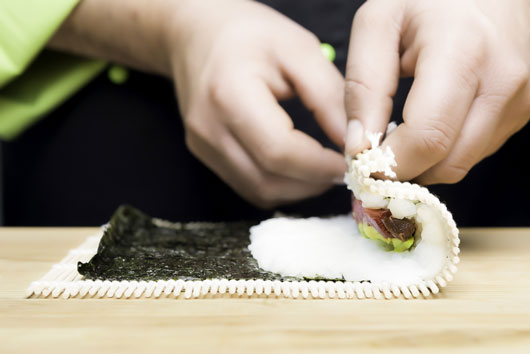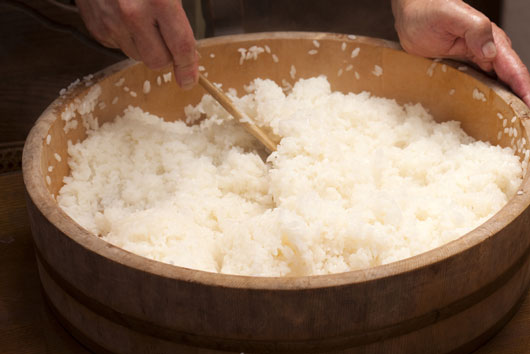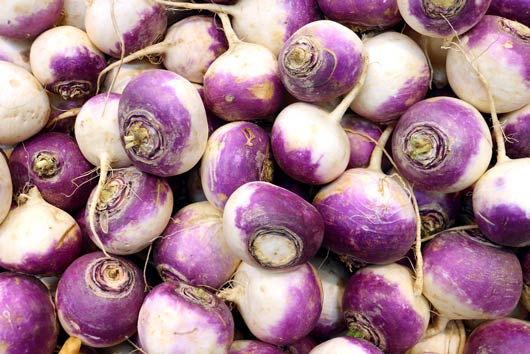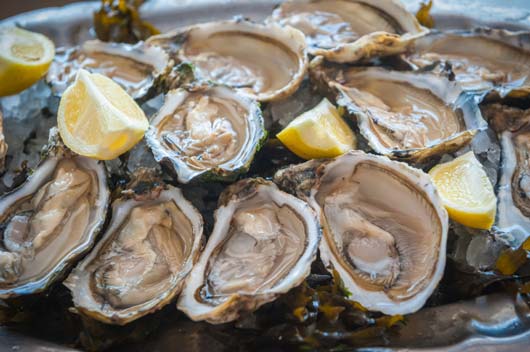
Raise your hand if you know how to master sushi recipes. After all, how hard could it be to roll up a ball of rice and slab some fish on it? Well, according to a student at one of Japan’s top sushi chef schools who spoke to Business Insider: “Sometimes I cry, but only when I’m at home on my own,” said Tetsuya Sakurai. Students find cutting the fish is like performing surgery. And removing the innards from a shellfish? Truly difficult. So, if cutting up fresh fish like salmon or tuna isn’t your thing, then pick up pre-packaged smoked salmon strips or imitation crabmeat for sushi rolls instead. For this beginner California Maki Roll recipe (which has the sushi rice on the inside with the nori on the outside), you’ll need: a half a pound of flaked imitation crabmeat, four sheets of nori seaweed, one avocado, half a cucumber sliced into small, thin strips, sushi rice, white sugar, rice vinegar, and finally, soy sauce, wasabi and pickled ginger slices for dipping the sushi when you’re done rockin’ and rolling up those makis.
Read Related: The Origin of Sushi: A Quick Culinary History
Perhaps the most important ingredient to get right for your DIY family sushi night is the sticky rice. Use only short-grained sushi rice since it’s starchy and absorbent, making it sticky-licious. Long-grained varieties like Jasmine, Basmati aren’t suitably absorbent, which make it dry and hard. You want to look for “long-grain sticky rice,” “sweet rice,” or “glutinous rice.” We highly recommend using a rice cooker since its makes rice consistently without constantly watching it or stirring. Making good sushi rice in a sauce pan is just plain hard, steaming takes a lot longer. Be sure to fully rinse your sushi rice with cold water prior to cooking to remove bran compounds or powder. If you skip this step, you’ll wind up highly sticky, smelly rice. And no one wants that in their sushi recipes.
Here’s some advice from the folks at the Denver Post: Once the rice is ready, place it in a large wooden bowl to cool a bit. For two thirds of a cup of rice, use three tablespoons of rice vinegar and two to three tablespoons of sugar for the rice vinegar mixture which gives sticky rice its signature sweet flavor. Warm the mixture over a low heat until the sugar dissolves; mix it up and let it cool. Then lightly sprinkle the vinegar mixture in small amounts over the rice, first vertically, then horizontally. Avoid simply pouring the warm liquid on the rice or it’ll clump into big balls of rice. Once your rice isn’t too hot to the touch, it’s ready for making sushi.

Finally, preheat the oven to 300 degrees Fahrenheit and on a medium baking sheet heat the nori sheets one to two minutes until warm. Next, lay out your bamboo sushi mat and center one sheet of nori on it. Wet your hands and use them to spread a thin layer of rice on the sheet of nori and press it down into a thin layer over the nori. Now arrange one quarter of the cucumber slices, ginger, avocado, and the imitation crabmeat, in a line down the center of the rice. Lift the end of the mat, and gently roll it over the ingredients, pressing gently. Then roll it forward to make a complete roll. Repeat these steps with the remaining ingredients. After that, cut each roll into four to six slices using the sharpest knife in the house, wetting it beforehand. Make sure to eat your maki rolls with chopsticks and serve them with soy sauce, wasabi and ginger. And don’t forget the sake for a celebratory toast!












